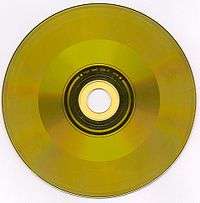CD Video
 | |
 | |
| Media type | Optical disc |
|---|---|
| Encoding | analog video + digital audio |
| Capacity | Up to 800 MB |
| Read mechanism | 780 nm wavelength semiconductor laser |
| Developed by | Sony, Philips, Panasonic, Samsung |
| Usage | audio and video storage |
| Optical discs |
|---|
|
Optical media types
|
|
Standards
|
CD Video (also known as CDV, CD-V, or CD+V) is a format of optical media disc that was introduced in 1987 that combines the technologies of standard compact disc and LaserDisc. CD-V discs are the same size as a standard 12-cm audio CD, and contain up to 20 minutes' worth of audio information that can be played on any audio CD player. It also contains up to 5 minutes of analog video information plus digital CD-quality sound, which can be played back on a newer LaserDisc player capable of playing CD-V discs.[1] One of the first LaserDisc players that can play CD-V discs is the Pioneer CLD-1010 from 1987. Though it is a CD-based format, CD Video was never given a rainbow book designation.
CD Video discs have a distinctive gold color, to differentiate them from regular silver-colored audio CDs. This is a characteristic that would later be replicated in HVD, a more advanced disc format.
A similar version of CD Video called Video Single Disc (VSD) was also released. It is basically the same as CD Video, but it only has the analog video track (occupying the whole storage space of the disc) and no audio CD tracks.
CD Video was targeted toward teenagers who watched music videos on MTV. However, few of them were familiar with LaserDiscs, and far fewer owned CDV-compatible players at the time. Buying a costly new player was not an option just for the minor use of playing a single music video that can be recorded with a VCR.
The term "CD Video" and its logo were also used on some full-size (8- and 12-inch) LaserDiscs with digital audio (for movies as well as for music titles), to distinguish them from the previous LaserVision format with analog audio and, presumably, to leverage the consumer recognition of the successful CD-Audio format.
Though CD Video lasted only a few years in the marketplace and began disappearing by 1991, its legacy would live on with the all-digital MPEG-based Video CD format, which came out a few years later in 1993.
References
External links
- IEC 61104 - Compact disc video system - 12 cm CD-V
- A webpage on CD Video discs, featuring a list of NTSC CD-V releases
- The LaserDisc Database, including CD Video